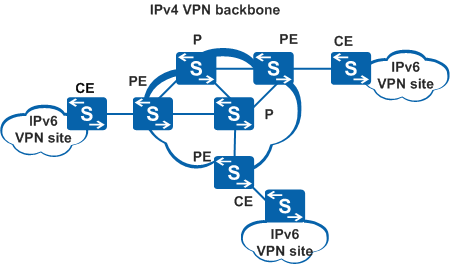Overview of BGP/MPLS IPv6 VPN
IPv6 is an enhanced version of IPv4 and an Internet protocol of the next generation. IPv6 provides the improved address space, configuration, maintenance, and security functions, and supports more access users and devices that access the Internet than IPv4. Some campuses and companies start using IPv6 addresses internally to address the problem of IPv4 address shortage. Currently, communication on IPv6 networks depends on the backbone IPv4 networks. The BGP/MPLS IPv6 VPN technology is used to establish internal IPv6 networks.
The BGP/MPLS IPv6 VPN is a Layer 3 virtual private network (L3VPN). BGP/MPLS IPv6 VPN uses the Border Gateway Protocol (BGP) to advertise VPN routes and the Multiprotocol Label Switching (MPLS) to forward VPN packets on backbone networks, which are IP networks, of service providers (SPs). "IPv6" here refers to the IPv6 packets transmitted by VPNs.
On an IPv6 VPN, a provider edge (PE) receives IPv6 packets from customer edges (CEs); however, on an IPv4 VPN, a PE receives IPv4 packets from CEs.
Currently, IPv6 VPN services are implemented through IPv4 backbone networks of SPs. In this case, the PE must support IPv4/IPv6 dual stack because the backbone network is an IPv4 network and the client sites use IPv6 address family, as shown in Figure 1. Any network protocols that can carry IPv6 traffic can be used between CEs and PEs. User-side interfaces on the PEs run IPv6, and network-side interfaces run IPv4.
Figure 1 shows the basic model of a BGP/MPLS IPv6 VPN.
IPv6 VPN uses Multiprotocol Extensions for BGP-4 (MP-BGP) to advertise VPNv6 routes on the backbone network, triggers MPLS to allocate labels for IPv6 packet identification, and uses tunnels such as LSPs and MPLS Traffic Engineering (MPLS TE) tunnels to transmit VPN data on the backbone network. The implementation principle of an IPv6 VPN is similar to that of a BGP/MPLS IP VPN.
Currently, the device supports the following IPv6 VPN networking schemes:
Intranet VPN
Extranet VPN
Hub and Spoke
Inter-AS VPN
For description about these networking schemes, see BGP/MPLS IP VPN Configuration in this manual.
